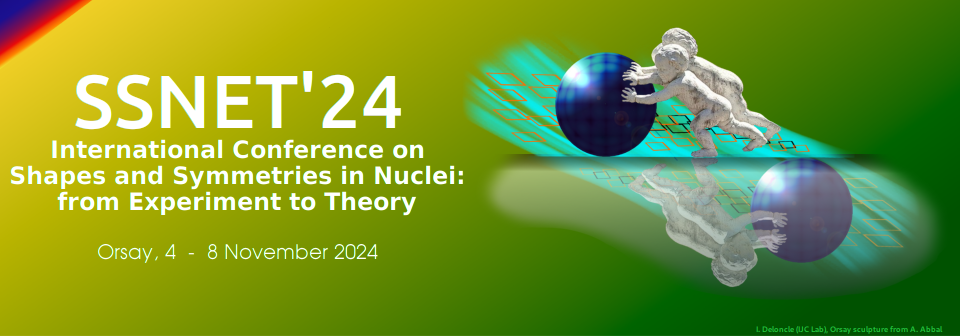Orateur
Description
We would like to present new results addressing the issues of nuclear stability induced by the presence of exotic symmetries in heavy nuclei. These mechanisms can in turn be seen as resulting from the specific shell effects (significant shell gaps in the single nucleon energy spectra) described using the language of magic numbers. In our context, we refer to them as 4-fold magic numbers, since the corresponding gaps are present at the same nucleon numbers, yet at non-vanishing all four octupole deformations $\alpha_{3\mu=0,1,2,3}\neq0$, often at $\alpha_{20}=0$. In our recent calculations, we were able to establish those properties in nuclei with neutron numbers close to $N=136$ (actinide region), cf. Ref.[1] and, independently, $N=196$ (superheavy region), cf. Ref.[2].
Our theoretical predictions are calculated by employing a realistic phenomenological mean-field approach with the deformed Woods-Saxon potential and its newly optimized parametrization, which contains no parametric correlations. Among 12 Woods-Saxon parameters, the presence of the correlations between 4 parameters was detected and removed using the Monte Carlo approach. The potential energy surfaces are deduced from the standard multidimensional deformation space ($\alpha_{20}$, $\alpha_{22}$, $\alpha_{3\mu}$, $\alpha_{40}$) in both actinides and superheavy nuclei regions, and show the well-pronounced double energy minima generated by the octupole shell gaps, which in turn generate the exotic group symmetries $C_{2v}$, $D_{2d}$, $T_d$, and $D_{3h}$, respectively.
With the help of the representation theory of the point groups, we produced the rotational bands generated by the symmetries. By analyzing the specific properties of the collective rotational bands generated by the symmetries, we formulate the quantum mechanical criteria for experimental identification of these exotic symmetries.
Our calculations show that among the four octupole deformations, octupole-tetrahedral $\alpha_{32}$ deformation plays an important role in stabilizing the superheavy nuclei around the $N=196$ region cf. Ref.[2]. In addition, in superheavy nuclei region $110\leq Z\leq 138$ and $166\leq N\leq 206$, the islands of the $D_{3h}$ symmetry with the nuclear equilibrium deformations with $\alpha_{33}\neq0$ combined with normal-deformed oblate $\alpha_{20}\approx-0.15$, super-deformed oblate $\alpha_{20}\approx-0.50$ and hyper-deformed oblate $\alpha_{20}\approx-0.85$ are predicted cf. Ref.[3].
[1] J. Yang, J. Dudek, I. Dedes, A. Baran, D. Curien, A. Gaamouci, A. Góźdź, A. Pedrak, D. Rouvel, H. L. Wang, and J. Burkat, Phys. Rev. C 105, 034348 (2022).
[2] J. Yang, J. Dudek, I. Dedes, A. Baran, D. Curien, A. Gaamouci, A. Góźdź, A. Pedrak, D. Rouvel, and H. L. Wang, Phys. Rev. C 106, 054341 (2022).
[3] J. Yang, J. Dudek, I. Dedes, A. Baran, D. Curien, A. Gaamouci, A. Góźdź, A. Pedrak, D. Rouvel, and H.-L. Wang, Phys. Rev. C 107, 054304 (2023).

